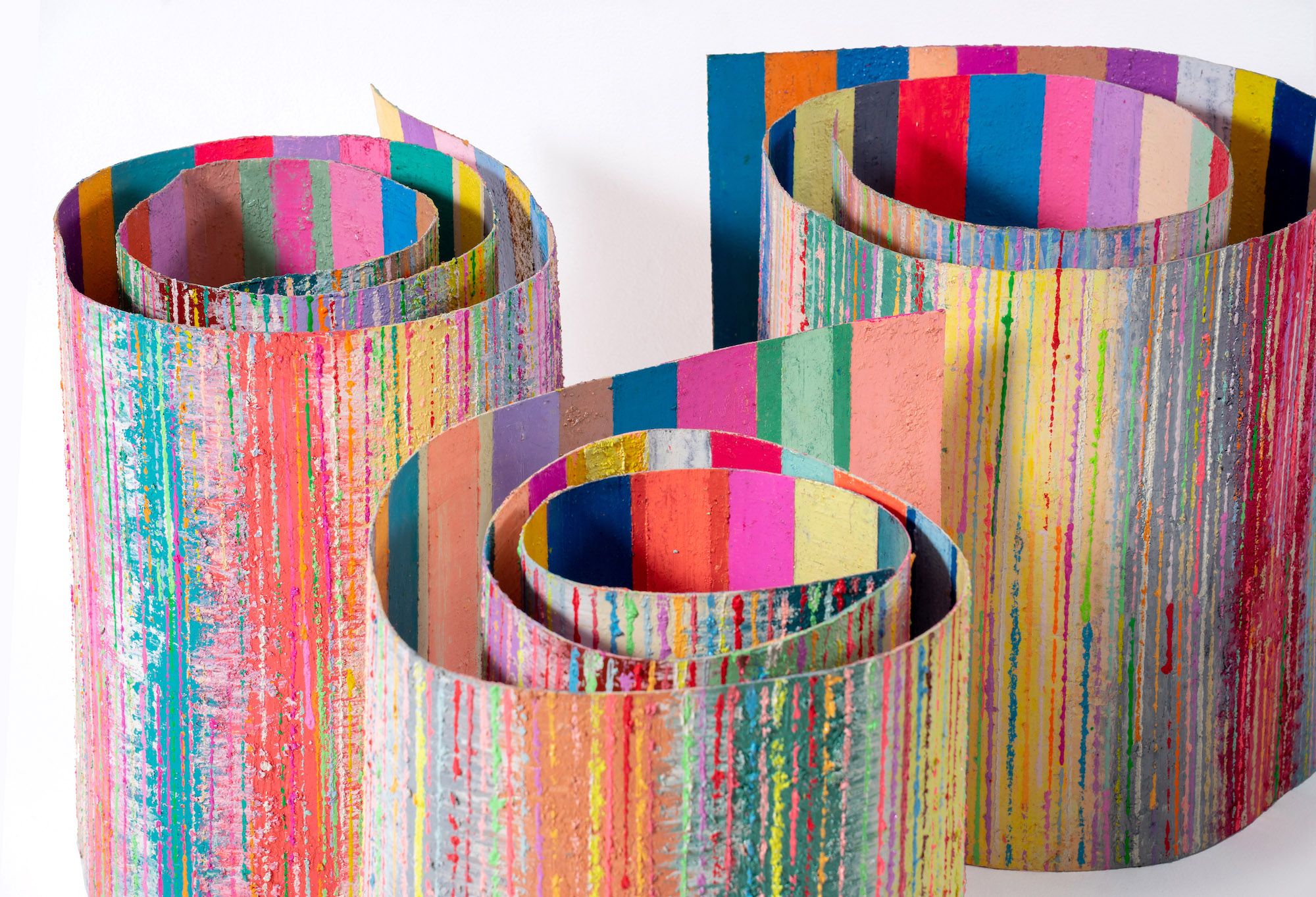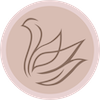Buddhism, Muay Thai and recycled paint. After experiencing Mit Jai Inn’s meditative vibrations through his conceptual art forms—a part of Rossi & Rossi’s current exhibition “Royal Marketplace”—contributing writer Phoebe Mille delved deeper into the untold story of Thailand’s humblest and best known contemporary artist.
TEXT: Phoebe Mille
IMAGE: Installation view, Mit Jai Inn: Royal Marketplace, at Rossi & Rossi, Hong Kong, 5 December 2020 – 11 February 2021. Photo by Kitmin Lee. Image courtesy of Rossi & Rossi.
Stepping into Rossi & Rossi in Hong Kong’s Wong Chuk Hang industrial area, I was immediately submerged in a wave of colour and texture. Unframed, auroral paintings twain in ridged texture whilst being juxtaposed by delicate pigmented pastels. Long strips of ribbon-like screens hanging from the ceiling throughout the front space, heavily layered with saturated paint and dripping with texture. Sporadically placed multicoloured scrolls of coiled canvases coated in viscous paint, hardened to create its structural shape bordered the room. Challenging the flux and flow of intermixing colours, textures and free flowing forms, the artworks intertwine harmoniously, radiating a calm peacefulness. “Royal Marketplace” presents selected bodies of work from renowned Thai artist Mit Jai Inn, exemplifying the artist’s approach to art-making, described as a meditative-like process in which he enters a complete state of consciousness whilst creating his painted forms, pushing the boundaries of colour, texture and structure.
Meeting Mit via Zoom, I immediately felt the essence of a calm, humble and kind-hearted person, yet I would also come to quickly learn the adverse major obstacles overcome throughout his life.
Born in 1960 amidst the chaos of the Vietnam War in Chiang Mai, Thailand, Mit shares how he unwillingly witnessed the invasion of communism, the collapse of society and how heavily this affected those in small villages. Choosing to run away to Bangkok at the age of nine he metaphorically likens the escape to a moth being drawn towards a flame of neon lights, music and freedom, a utopia free of traditional pressures and full of modernity. Even now, Mit’s artworks reflects the impression of the city’s ever-present light, sound, and vibration mimicked through his choice of pigments and composition of colour. Being a young boy on the streets of Bangkok however was not something he could completely control or facilitate. It was not long before Mit was picked up by the authorities and his life took an ironic and unforeseeable shift, as Mit would face the discipline he had adamantly tried to escape.
Mit was subsequently placed in a Buddhist monastery where he was subjected to a strict regimen and education for the next seven years. This strong narrative can be telling, and is often demonstrated in Mit’s art. The screen-like paintings that hung in the gallery evoke spiritually charged colours, a sense of ceremony, and of portals marking beginnings or endings as taught in Buddhist traditions. “I want people to be awakened and feel the vibration of positivity and total consciousness whilst reconnecting with their inner peace. I would hope that this reset allows a relief from the struggle our spirit is affected by,” Mit proclaims.
Mit goes on to tell me whilst participating in traditional and cultural Thai practices, he had also taken very modern, Westernised classes such as English Language, German Philosophy and Art History. Mit reflects on the profound effect art had throughout his education as a monk and recalls learning about American Modern Art, German Expressionism and Russian Constructivism. “Being young and aggressive this drove my desire to escape traditions and be exposed to the modernity of the Western world. It was a complete clash of two worlds and a time of struggle for me, mentally and ideologically. Hormones and trauma were negatively controlling my psyche, however, the Buddhist practice allowed me to control my anger and become peaceful when I needed to be. Ultimately during my time at the monastery, I embraced traditional Buddhism whilst also absorbing knowledge through modern education.”
Mit describes how he pours his inner peace and calm into his paintings, untangling his exposition of bright pigmented pastels and layered tactile texture. Willing participants are encouraged to touch and interact with Mit’s artworks so as to feel its vibration and energy. Mit shares how his work represents “psychedelic outer body experiences” like those commonly sought after in recreational drug use, but can easily and alternatively be found within our limitless consciousness without restriction. “Call this spiritual if you like, perhaps through my paintings I try to represent this spiritual or subconscious colour of connection,” he says. “You may not understand why, but you will feel it and your consciousness will get it. It cannot be explained by the brain, the eye or the senses, but your consciousness and spirit will understand.”
At the age of 16 he left the monastery to pursue Muay Thai. I thought it strange initially, believing the violence of boxing would oppose the peaceful teachings of Buddhism. Yet contrary to my misconception, Muay Thai combines historical, moral and spiritual beliefs. Mit explains, “Thai Boxing is a dance in the present moment, flowing with the situation, like the Buddhist practice”. Mit’s abstract paintings further echo these paradoxes and the duality we all frequently unearth every day, comparing the roughness of form counteracted by the bright colours similar to the duality of aggression and respect seen in Muay Thai.
“In Thai boxing you can be hurt and broken physically but this is an example of our reality, when you face it there is nothing you cannot face in life,” says Mit. The artist shares how the discipline of Muay Thai also teaches one to let go of the ego that renders us ineffective. “When I would have a good match and start to build an ego I would lose, I would be knocked out immediately like a strange karma. It is the same in life, if you think ‘oh I am prettier’ or ‘I am better’ you will immediately be knocked out in life. It is better to be mindful and have respect.” He explains, “Society can twist us to be egotistical, everybody wants to be someone and I think my time as a monk and a Thai boxer has allowed me to let go of this. There will always be a trace of ego and aggression, but I can use this practice to let it go and if all else fails I can camouflage this through my art.”
Mit’s curiosity, humble nature and ardent disposition has taken him all over the world in search of different cultures and art techniques. In many ways those experiences were the most formative, as was during his time abroad when the artist came about his signature paint making technique. Studying at the University of Applied Arts in Vienna, Mit struggled to afford luxury items such as paints and brushes and constantly faced the predicament of having to present his work in class on a weekly basis. One night he thought up an alternative possibility and took a chance on its outcome. “I decided to crack and peel the paint off my previous works and then crush and mix it with linseed oil, as to make it soft and usable again, and it worked! The process has since stuck with me,” he explains. After his studies Mit travelled through Europe moving from studio to studio. Not having the time or funds to make a frame he would fold up or roll his painted canvases. “The paint would crack, so what I did was teach myself how to do adjust the paint, so it was flexible even after it has been applied to the canvas.”
Mit relocated back to Thailand in 1992, and is now arguably one of the best known contemporary artists in Thailand. Aside from painting, Mit focuses much on collaborating with local activist and art groups, as well as nurturing the next generation of Thai artists. During our video call he takes me on a tour of his studio, inundated with mounds of paints scattered over multiple workstations, showing evidence of crushing and mixing colour of his own making. Painted canvases drape over tables and hang from metal beams, coated in texturised paint on both sides. As he shows me around, a small fluffy dog follows ahead of him, dashing across the canvas. “Just like people I don’t mind all beings interacting with my work, it gives the pieces more energy!” says Mit.
Off the beaten track, outside of Bangkok, Mit’s studio is surrounded by trees, wildlife, and most importantly, the artist adds, sun and moonlight with nocturnal interludes of white fluorescents when needed. Seeking to reach his highest state of consciousness, Mit stresses the importance of his studio being open and exposed, an aid in his daily pursuit of seeking quiet, peace and being awake in the present.
Mit Jai Inn: Royal Marketplace
5 December 2020 – 11 February 2021*
Rossi & Rossi, Hong Kong
*The exhibition has been extended to run through 11 February 2021.










